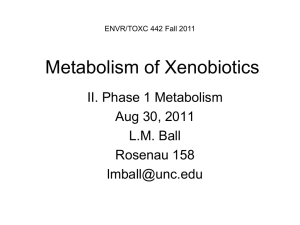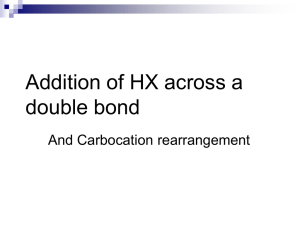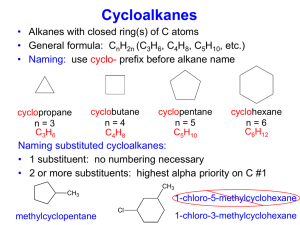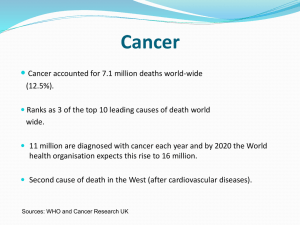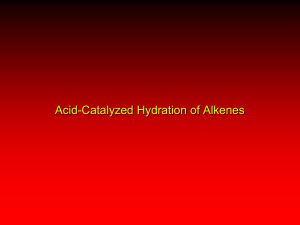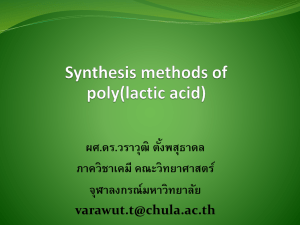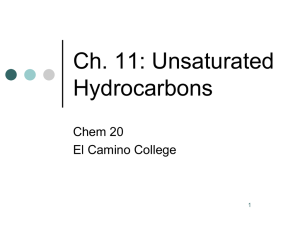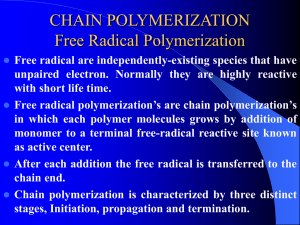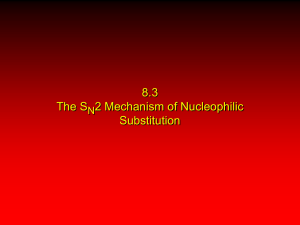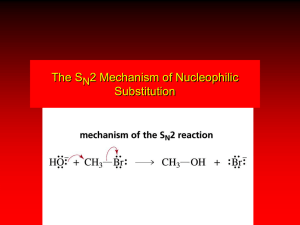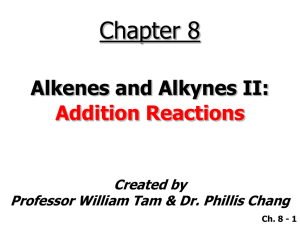REBECCA MPHARM II PROJECT PPT 12 Nov 2014
advertisement
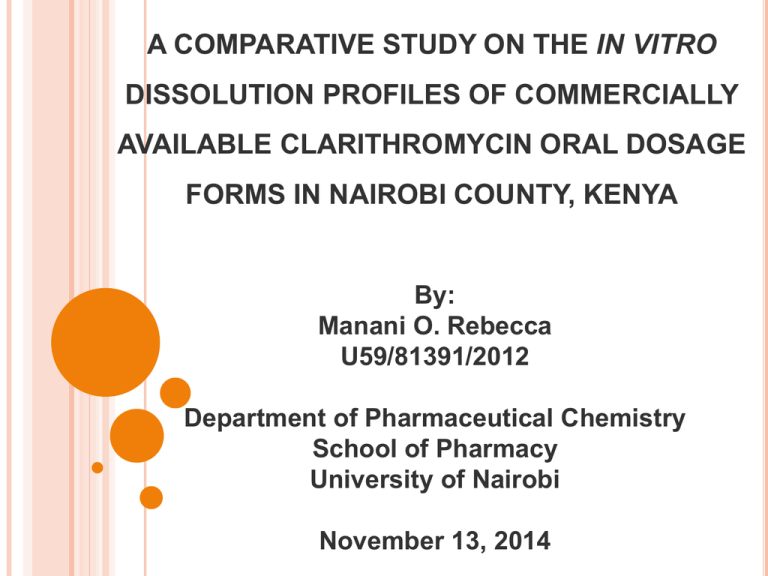
A COMPARATIVE STUDY ON THE IN VITRO
DISSOLUTION PROFILES OF COMMERCIALLY
AVAILABLE CLARITHROMYCIN ORAL DOSAGE
FORMS IN NAIROBI COUNTY, KENYA
By:
Manani O. Rebecca
U59/81391/2012
Department of Pharmaceutical Chemistry
School of Pharmacy
University of Nairobi
November 13, 2014
OUTLINE
Introduction
Study justification
Study objectives
Methodology
Results and discussion
Conclusion
Recommendations
Acknowledgements
2
INTRODUCTION: MACROLIDES
Natural
and
semi-synthetic
antibiotics
characterised by macrocyclic rings with attached
sugars
Source:
species
Classification
Streptomyces
and
micromonospora
14– erythromycin, clarithromycin, roxithromycin
15 – semi-synthetic azalides: azithromycin,
gamithromycin
3
16 – josamycin, spiramycin, rokitamycin
MACROLIDES (CONT’D)
Mode of Action
Inhibit protein synthesis; prevent transpeptidation
Spectrum of Activity
G+ve: S. aureus, Str. pyogenes, Str. pneumoniae
G-ve: H. influenzae, N. meningitidis, H. pylori
Atypical: M. pneumoniae, C. trachomatis,
Mycobacteria, Toxoplasma, Borrelia spp.
Limitations of Natural Macrolides
Acid instability, GIT side-effects, resistance,
narrow spectrum
4
CLARITHROMYCIN
Chemistry
2nd generation semi-synthetic macrolide
H3C
CH3
O
H3C
HO
9
6
OH
CH3
3
O
1
O
OCH3
CH3
H3C
HO
O
CH3
H3C
CH3
O
OCH3
OH
O
O
H3C
H5C2
CH3
H3C
O
CH3
Clarithromycin
CH3
OCH3
OH
O
O
CH3
CH3
O
O
O
Erythromycin A
CH3
N
HO
HO
O
12
H3C
H5C2
H3C
CH3
HO
5
HO
N
CH3
CH3
5
STABILITY OF CLARITHROMYCIN
O
H3C
CH3
O
OCH3
CH3
H3C
HO
N
O
O
CH3
H3C
O
CH3
O
CH3
O
H3C
O
N
Decladinosylclarithromycin
H3C
H5C2
O
CH3
H3C
CH3
O
9,12-Hemiketal
CH3
OCH3
OH
O
O
Oxidative; basic; acidic conditions
CH3
O
O
O
N
HO
O
CH3
CH3
H3C
OCH3
CH3
O
CH3
CH3
CH3
CH3
H3C
O
OH
O
10,11-Anhydroclarithromycin
HO
HO
CH3
OCH3
OH
O
CH3
CH3
O
CH3
H3C
O
Clarithromycin N-oxide
H3C
H5C2
O
O
H3C
H5C2
O
OCH3
CH3
HO
HO
CH3
OCH3
OH
O
H3C
HO
OCH3
CH3
H3C
CH3
N
O
HO
HO
H3C
H5C2
H3C
CH3
CH3
CH3
6
STUDY JUSTIFICATION
Quality of drugs crucial in treatment outcomes
Previous reports of poor quality products in 3rd
world countries
Clarithromycin is in EML - Kenya, WHO
BCS classification
Tablets – class II (Low aq. solubility, low permeability)
Suspensions – class IV (Low aq. solubility, low
permeability)
Generics used as a cost cutting measure
No bioequivalence testing centres in Kenya
No previous PMS studies on CLA in Kenya
7
STUDY OBJECTIVES
General Objective
To conduct comparative in vitro dissolution
studies on oral clarithromycin products in
Nairobi County
Specific Objectives
To carry out product sampling in Nairobi County
To carry out identification and assay tests
To carry out comparative dissolution testing –
innovator, generics
To determine pharmaceutical equivalence
8
METHODOLOGY I: SAMPLING
Study population – 125 mg/5 mL susp, 500 mg
tablets
Time frame – January to March 2014
Stocking patterns revealed uneven distribution
Sites –11 outlets in Nairobi, 1 in England, UK
16 samples – 12 tabs and 4 suspensions (67%
stocking rate in Nairobi)
Sample size – 60 tablets and 500 mL
suspensions
9
METHODOLOGY II: METHOD OPTIMIZATION
MOA – published method (Abuga et al. 2001)
Method optimization
Detection wavelength, Sample injection volume, Mobile
phase flow rate
Quenching conditions - dissolution pH 1.2
Optimum conditions: mp - ACN-0.2 M phosphate
buffer, pH 6.80-water (40:3.5:56.5, v/v/v), flow
rate -1.5 mL/min, sp - XTerra RP C18, 5 m (250
mm x 4.6 mm ID), temp - 56 oC detection 205
10
nm, quenching – 3 mL of 0.2 M NaOH
METHOD OPTIMIZATION (CONT’D)
mAU
205nm,4nm (1.00)
CLA
125
100
75
50
25
0
-25
-50
-75
0.0
5.0
10.0
15.0
20.0
min
Fig.1 - Typical assay chromatogram for
clarithromycin working standard under the optimum
chromatographic conditions
11
METHODOLOGY III: ASSAY AND DISSOLUTION
USP and BP methods for sample preparation
Tabs – uniformity of weight (BP), assay
Granules – RD, extraction (USP), assay
Dissolution carried out at pH 1.2, 4.5, 6.8
Run time - 60 min. tabs, 90 min. suspensions
6 sampling time points
Dissolution profiles generated and f2 factors
calculated
f = 50×log {[1+ (1/n) Σ t=1n (Rt-Tt) 2] -0.5 ×100}
2
12
RESULTS I: ASSAY
Table 1 (a) – Assay Results for CLA Tablets
Sample
Code
C1
% Content
100.9 100.2 100.1 102.1 98.8
C8
C2
C3
C9
C4
C5
C6
C7
99.3
98.7
C10
C11
C12
C17
101.5 102.0 98.8
98.4
105.9 103.5
Table 1 (b) – Assay Results for CLA Suspensions
Sample
Code
C13
C14
C15
C16
C18
% Content
107.8
108.8
99.5
109.6
110.1
13
RESULTS II: ACIDIC DEGRADATION
CLA std incubation - 37 oC in 0.1 M H3PO4 (pH 1.4)
and 0.1 M HCl (pH 1.2)
Table 2 – Acid Degradation Parameters for CLA Std
Degradation
Parameters
pH 1.4
pH 1.2
Half life (min)
185
36.7
Rate constant (min-1)
3.7 x 10-3
19 x 10-3
% API degradation in
40 min
13.8
60
14
RESULTS III: DISSOLUTION AT PH
mAU
205nm,4nm (1.00)
1.2
150
125
DECL
100
75
50
25
CLA
0
-25
0.0
5.0
10.0
15.0
20.0
min
Fig. 2 – Chrm for dissolution at pH 1.2, 30 min.
Dissolution
proceeded
with
concurrent
degradation – profiles created using Total
Clarithromycins
15
RESULTS IV: F2 FACTORS AT PH
1.2
Fig. 3 – Similarity factors at pH 1.2
16
Compliance rate 50% (6/12)
RESULTS V: F2 FACTORS AT PH
4.5
Fig. 4 – Similarity factors at pH 4.5
17
Compliance rate 67% (8/12)
RESULTS VI: F2 FACTORS AT PH
6.8
Fig. 5 – Similarity factors at pH 6.8
Compliance rate 50% (6/12)
18
F2 FACTORS
– COMPLIANT SAMPLES
Table 3: Similarity factors for compliant samples
Sample
Code
Dosage
Form
C1
f2 factors (%)
pH 1.2
pH 4.5
pH 6.8
Tablet
80.4
93.6
54.8
C6
Tablet
54.6
52.4
64.4
C11
Tablet
64.7
80.9
61.8
C17
Tablet
72.2
75.2
55.2
19
Overall compliance rate 25% (4/16 products)
F2 FACTORS
– NON-COMPLIANT SAMPLES
Table 4: Similarity factors for non-compliant samples
Sample
Code
Dosage
Form
f2 Factors (%)
pH 1.2
pH 4.5
pH 6.8
C2
Tablet
46.0
30.0
54.8
C3
Tablet
40.2
53.7
35.5
C4
Capsule
69.2
16.9
26.5
C5
Tablet
28.8
61.5
33.3
C7
Tablet
37.9
25.3
27.6
C8
Tablet
58.9
69.5
45.4
C9
Tablet
44.8
34.2
34.7
C10
Tablet
22.2
56.6
79.7
C13
Susp.
ND
ND
42.4
C14
Susp.
ND
ND
14.3
C15
Susp.
ND
ND
15.2
C18
Susp.
ND
ND
42.0
20
DISCUSSION
Variability in product performance
Table 5 – Inconsistent Products
Product
Code
C2
C8
pH 1.2
46.0
58.9
C10
22.2
f2 factors (%)
pH 4.5
pH 6.8
30.0
55.8
69.5
45.4
56.6
79.7
Gastric pH 0.5 - 2 adults, 1.5 - 3 children, 2 sick
state
Gastric residence time 0.5 – 2 hrs
Significant degradation noted at 30 min, pH 1.2
21
DISCUSSION (CONT’D)
Variability in performance of innovator products
in different markets:
pH
1.2
4.5
6.8
f2 Value (Tabs)
72
75
55
f2 Value (Susp.)
ND
ND
42
Significant differences not expected due to
change in site – GMP, SUPAC-related
guidelines
Minimal API release for suspensions C14 and
C15 – implications of sub-optimal product
dissolution
22
CONCLUSION
Not all available CLA products meet quality
standards
Proof of quality and pharmaceutical equivalence
requires more than assay and single point
dissolution tests
Role of DRAs critical in QA of pharmaceuticals
Pre-registration
Pharmacovigilance
targeted
-
effective,
sustained,
23
Staff – proper education, training, experience
RECOMMENDATION
In vitro dissolution profiling to be included in
routine QC and post-marketing surveillance
tests
Sustained PMS and PV activities by DRAs
Sufficiently deterrent measures for noncompliant products by DRAs to discourage
circulation of poor quality products
Further studies on other antibiotics in
circulation, special attention paid to macrolides
24
ACKNOWLEDGEMENTS
Supervisors - Dr. K. O. Abuga
- Dr. H. K. Chepkwony
NQCL management and staff
University of Nairobi
Ministry of Health
Technical staff – C. Rotich, D. Nyamweya, J.
Kalama, H. Mugo, O. King’ondu, J. Nguyo
25
26
